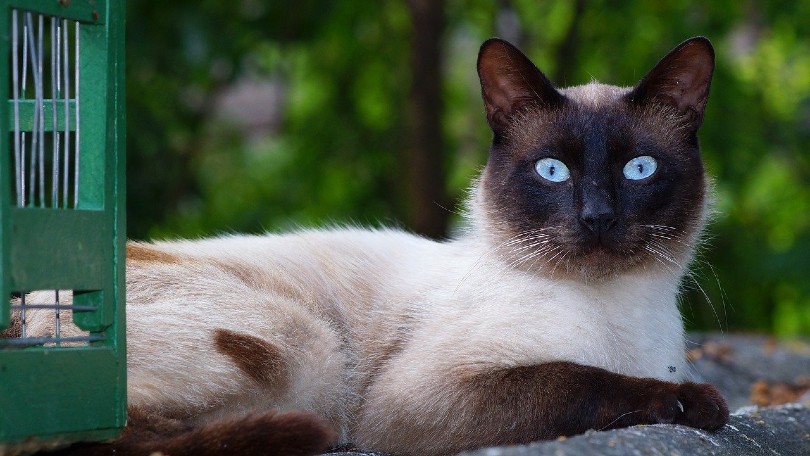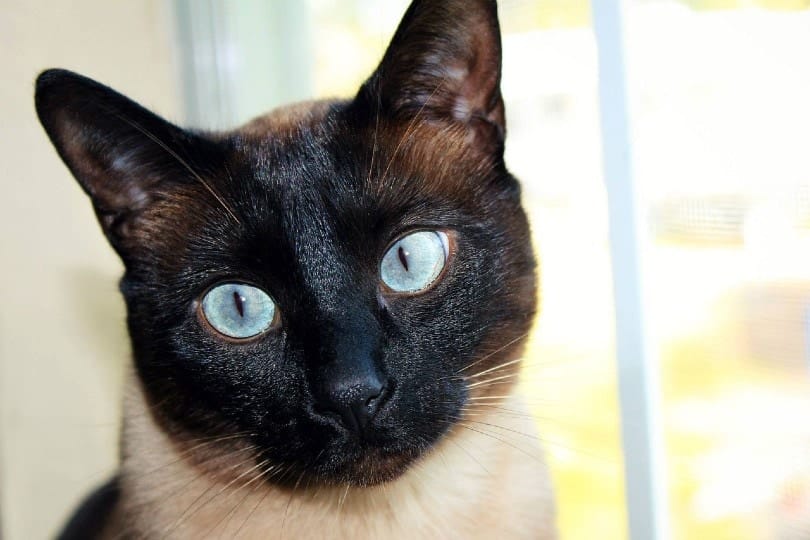Click to Skip Ahead
Breed Overview
Height:
10–12 inches
Weight:
5–11 pounds
Lifespan:
10–13 years
Colors:
Creamy white fur on the body with points in a wide range of colors
Suitable for:
Families looking for a heavier Siamese-type cat who resembles the traditional Thai breed that the Siamese is originally descended from
Temperament:
Loyal, talkative, affectionate, and playful
While the breed that most of us recognize as Siamese has an angular face, elegant thin bodies, and large eyes, this “classic” Siamese silhouette is a relatively modern development in this breed. The traditional Thai breed that the Siamese comes from was actually descended from a larger, rounder type of cat.
Breeders in some areas have returned to this traditional Siamese shape, and these cats are known as Applehead Siamese. These cats share many of the same character traits as any other Siamese but have different body shapes. Some breed registries refer to the Applehead Siamese as the Thai breed, though.
If you’ve found yourself wishing for a Siamese cat with a muscular body and a more rounded face, you’re in the right place. Applehead Siamese cats are playful, vocal, and intelligent, just like any other Siamese cat.
We’ll tell you everything you need to know about the eye-catching Applehead Siamese so you’ll be ready to start looking for that perfect new kitten.
Applehead Siamese Kittens — Before You Bring One Home …
Siamese kittens are adorable, but don’t be surprised if you visit a litter only to see snowy white kittens! Their breeder isn’t pulling a fast one—all Siamese kittens are born white. Their points only develop as the kittens mature.
Even though those kittens are extremely cute, we recommend waiting until you’re 100% sure that bringing home an Applehead Siamese is the right thing for you and your family before you commit yourself. Applehead Siamese cats crave their owner’s attention, so they’re not the sort of cat that you can leave home alone every day while you’re at work.
Applehead Siamese cats are just like any other Siamese cat in that they’re very talkative. This means you can look forward to a constant stream of chatter from your cat. They might feel like telling you that it’s raining outside, a bird just landed on their feeder, or their water bowl is empty—the list goes on! Some owners find this incredibly endearing, and hopefully, you fall within that group! But for others who might prefer a quieter cat, it can become a little grating.
Applehead Siamese cats are also incredibly loyal, so don’t be surprised if they form strong bonds with their human family members. They can also be territorial, so sometimes, they’re happier as a single cat—more attention for them, of course!
What’s the Price of Applehead Siamese Kittens?
Siamese cats are a popular breed, but the Applehead variety is less so. Applehead Siamese cats might be pedigree, but many modern show rings will mark them down for being not Siamese enough. They are starting to become more popular, though, as more breeders and owners are starting to see that the Applehead is actually closer to the traditional appearance of the Siamese breed.
You will need to take the time to find a breeder who specializes in producing Applehead Siamese cats. Their price will vary, but we recommend expecting to pay somewhere between $800–$1,500. Many Applehead Siamese cats can be registered as pedigree Siamese, although their traditional appearance can sometimes count against them if you want to show them. Since the Applehead is becoming more popular, some shows are starting to offer separate classes for them.
It’s possible that you’ll find kittens cheaper, but bear in mind that these may be mixed breeds, with one Siamese parent and one parent of another breed. This might be totally fine with you, but make sure you’re aware of that fact so you don’t think that you’re getting a pedigree Applehead Siamese for a bargain price.
All honest breeders will be able to provide paperwork for both parent cats, including any health tests that they may have had. If you can, it’s a good idea to visit the breeder’s facilities and meet both parent cats. Asking for references can also help you establish if a breeder is trustworthy. If they are, they will be more than happy to answer any of your questions.
If you have a particular pointed color in mind for your new kitten, bear in mind that all Siamese kittens will be born white. Their color will develop by the time you’re ready to take them home, but you may not be able to specify a color preference if you have to reserve a kitten in advance. Depending on the parent’s point coloration, an experienced breeder may be able to tell you the possible colors of the kitten’s points.

3 Little-Known Facts About Applehead Siamese
1. Applehead Siamese cats look more like the traditional Siamese breed.
The svelte body and angular-shaped head of the Siamese breed these days are the result of generations of breeding concentrating on those particular characteristics. This has taken the appearance of the Siamese breed further away from the original Thai cats that were exhibited in the 1980s.
It also led to health problems, including eye and ear defects and kidney and cardiovascular issues. As a result, some Siamese breeders decided to try and return to breeding Siamese cats with a more traditional appearance. That’s how the Applehead Siamese came to be!
Siamese cats were originally muscular, with rounded heads, smaller ears, and softer angles across their whole bodies. If you’ve seen photos of or met a modern Siamese cat, you’ll see that they don’t fit this description at all! Breeders of Applehead Siamese cats may have introduced other breeds, like the British Shorthair, to try and return to a more traditional Siamese appearance.
In the U.K., you might see the Applehead Siamese called “old style”. Applehead was originally used as a bit of an insult, but of course, plenty of families and breeders love the appearance of these sweet cats, so it’s evolved into a description of this particular branch of Siamese heritage.
2. The TICA calls Applehead Siamese cats the Thai breed.
One way to distinguish between the modern Siamese breed and the Applehead Siamese has been to refer to them as two separate breeds. The International Cat Association registers Applehead Siamese cats as the Thai breed.
In Thailand, the Applehead Siamese is also called the Wichienmaat, and in Europe, they’re commonly called the “Old Style Siamese”.
3. Siamese kittens are all white when they’re born.
The reason for the Siamese cat’s distinctive pointed coat is a gene known as the Himalayan gene. This causes temperature-sensitive albinism, with warmer areas of the coat not developing color.
Due to the warm temperature of a mother cat’s womb, all Siamese kittens are born white. As their bodies respond to the change in temperature, their points will start to develop. The cooler temperature of their legs, ears, face, and tail means that the hair there will become pigmented.

Temperament & Intelligence of the Applehead Siamese
In addition to their beautiful pointed coats, Applehead Siamese cats are affectionate, playful, and outgoing. They share all the same characteristics as the Siamese breed itself. These cats love attention, so they will often follow you around the house and talk to you as you go about your business.
Their sense of play means you’ll often find your Applehead Siamese doing slightly silly things, like seeing what small objects they can balance on, climbing to the highest point that they possibly can, or exploring a cupboard to see if anything is interesting in there.
These cats are chatty but not overly loud. They’ll be sure to let you know if they’re hungry or would simply like attention. If a meow or chirp doesn’t work, they may tap you with their paw or come and stand in front of you and demand your attention.
Applehead Siamese cats are happiest when they have human company, so don’t expect to be able to leave them at home all day while you’re at work. You may come home to find ornaments knocked over, curtains pulled down, and other forms of havoc! If you don’t give an Applehead Siamese enough attention or entertainment, they will make their own fun, and it usually involves making a mess!
Are These Cats Good for Families?
Applehead Siamese cats love to belong to a family, and you might need a few people to help keep these curious cats entertained! Applehead Siamese cats are loyal and usually form strong bonds with all their family members. They may develop a preference for one person in particular, but they will demand attention from everyone!
The playful and inquisitive nature of Applehead Siamese cats means they can make great playmates for kids as long as the children know how to interact safely with cats. This breed loves learning tricks and playing games, and they’ll always be up for attention.
Does This Breed Get Along With Other Pets?
All Siamese cats, including the Applehead, can be protective of their territory when it comes to sharing it with another cat. This can make introducing a new cat into a house with an existing Applehead more of a challenge. It will depend on the personalities of each cat, their age, and sex.
There are a few different steps that you can take to make the introductions easier, such as using a pheromone spray or diffuser, giving each cat their own “zones” of the house where they can retreat to, and making sure they won’t need to compete over resources by providing plenty of different places with food, water, and litter boxes.
Speaking to a cat behaviorist or your vet can help make the transition easier, as they will have plenty of tips and tricks to share.
Applehead Siamese cats often enjoy living with dogs, as it means they always have company! Depending on the personality of your cat and dog, they may play together or find a cozy spot to curl up for a nap.

Things to Know When Owning an Applehead Siamese
Deciding to become the owner of an Applehead Siamese takes more than just buying a new kitten. You’ll need to invest plenty of time and money into the health and welfare of your new kitten as they grow into a mature cat. Before you make up your mind, here’s more information that you might find useful.
Food & Diet Requirements 
Applehead Siamese cats have plenty of energy, so they need a good quality cat food with a high percentage of protein to help them build lean muscle. Look for a feed that uses real meat as the first ingredient and doesn’t contain fillers, meat by-products, or any artificial colors or flavors.
Whether you choose to feed kibble, wet food, or raw food to your cat will depend on your budget and preferences, as well as what your cat prefers!
If your Applehead Siamese is going to live indoors, then consider selecting a food that’s specifically designed to meet the requirements of indoor cats. These foods tend to contain fewer calories, as indoor cats are usually more sedentary than outdoor cats and can be at higher risk of putting on weight. These foods often have a higher fiber content, too, which can help with reducing hairballs.

Exercise
As an active and playful breed, you’ll want to provide plenty of opportunities for your Applehead Siamese to use up their energy. These cats love to climb, so consider adding vertical enrichment in the form of cat hammocks, trees, and scratching posts. You could also set up an outdoor cat enclosure to give your indoor cat a safe place to enjoy the fresh air.
Make sure your cat has many toys to play with, as these will help them feel like the tiny hunters that they are. You can also get food puzzles or toy mice that you can hide food in for your cat to find.
Some Applehead Siamese cats will enjoy going for walks using a harness and leash. It’s a good idea to spend plenty of time at home training them to feel comfortable with this before you head outside.
Training
Applehead Siamese cats can love the challenge of learning new tricks. It helps keep their brains active, which in turn, helps them chill out and relax later! From walking on a leash to learning how to sit, stay, and even high-five, these clever cats are more than capable of picking up a wide range of commands.
Using positive reinforcement with a clicker and treats is one of the best ways to effectively train your Applehead Siamese cat.
Grooming ✂️
The coat of Applehead Siamese cats is silky soft, with a thin undercoat. It’s easy to keep clean with a quick weekly brush.
Health and Conditions
As with any Siamese, the Applehead or Thai breed can suffer from a few health conditions. It’s always a good idea to speak to your kitten’s breeder and ask for more information, including whether the parent cats have had any health tests and, if so, which ones.
- Asthma
- Lower airway disease
- Bronchial disease
- Cancer
- Lens luxation
- Progressive retinal atrophy
- Liver problems
- Hypertrophic cardiomyopathy
- Pancreatitis
Male vs Female
If you’re sure that the Applehead Siamese or Thai cat is the right breed for you, then you might be wondering whether you’d prefer a male or female cat. Remember that the personality of each cat won’t be dependent on their sex, so we’d suggest choosing your kitten based on their personality rather than if they’re male or female.
You might be imagining an outgoing male kitten, only to discover that the females of the litter are braver!
Final Thoughts
Applehead Siamese cats are also called the Thai breed or Old Style Siamese. They have all the classic character traits of the Siamese breed but retain a more traditional appearance with their chunky bodies and rounded heads.
They’re outgoing, playful, smart, and affectionate. Life with an Applehead Siamese will never be boring! These cats simply love spending time with their humans, although you may need to come to terms with the fact that you’ll be under your cat’s command forevermore!
Applehead Siamese cats may need more attention and interaction than your average cat, so make sure you can dedicate enough time to giving them what they need. If you do, they’ll repay you with plenty of affection and loyalty. If you’ve got an Applehead Siamese, we’d love to hear more about your charismatic cat! You can get in touch using the comments section below.
See also:
- Applehead vs Wedgehead Siamese: What’s the Difference? (With Pictures)
- Chocolate Point vs Seal Point Siamese Cat: What’s the Difference? (With Pictures)
Featured Image Credit: MLARANDA, Pixabay
















